Utilizing Hydrovacs for Directional Drilling Projects
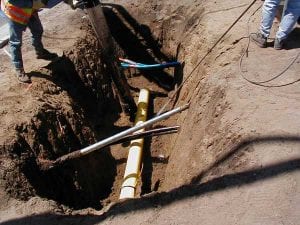 Horizontal directional drilling, or HDD, is a method of installing pipeline, conduit, and cables in a typically shallow arc. HDD is often used when traditional excavating and trenching is not feasible and disturbing the surrounding area is not possible. It is considered a less invasive practice than traditional cut and cover utility installation.
Horizontal directional drilling, or HDD, is a method of installing pipeline, conduit, and cables in a typically shallow arc. HDD is often used when traditional excavating and trenching is not feasible and disturbing the surrounding area is not possible. It is considered a less invasive practice than traditional cut and cover utility installation.
Though HDD is considered less invasive, it can cause damage to existing underground utilities if proper steps aren’t taken before beginning.
A hydrovac unit is a great option to complete prep work prior to horizontal directional drilling. The high-pressure water and powerful vacuum system of a hydrovac is strong enough to clear soil and debris of all types – including rock and sand – while not causing damage to existing underground utilities.
Due to these characteristics, hydro-excavating can play several roles in an HDD project.
First, a hydrovac can be used to excavate the entry well, which is the location where the HDD bit will enter the ground and collects returning drilling/lubrication or liquid/mud. This step has traditionally included the work of a shoveled excavator. However, this type of equipment is prone to damaging existing utilities that are underground. A hydrovac can complete this task without causing damage.
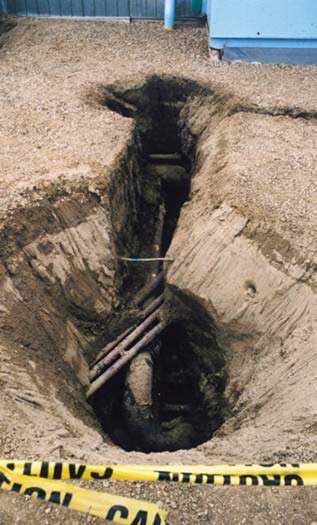
Second, a hydrovac is the ideal option to daylight the jobsite, exposing and locating any utilities in the ground. Utilizing the handgun on the hydrovac unit, an operator can precisely cut and remove soil from exact locations, mitigating the need to dig up entire sections of a jobsite. Daylighting with a hydrovac causes minimal disruption to the surrounding area. Once utilities have been located, operators can verify any utilities already installed and ensure that the drilling of new pipeline will not interfere with these established lines.
Third, a hydrovac can utilize its vacuum capabilities to reclaim the lubrication/drilling liquid used to install the new pipeline.
Using a hydrovac for prep and final work on a horizontal directional drilling project can save operators time and ensure that established utilities are not damaged in the process. Having a hydrovac on site for these types of jobs can positively affect overall costs and efficiency on the job.
Vac-Con offers a range of products to meet the needs of public utilities, telecommunication companies, construction contractors, and more. Check out our latest product – the All-New X-Cavator – to see if it could be a fit for your next HDD job. We also offer trailer-mounted options that bring you the power in a portable unit. Learn more here.
Tips to Help You Find the Right Hydrovac
Whether you are looking to purchase or rent a hydrovac unit, this decision is important and should be focused on the capabilities you require to get your projects completed.
We’ve outlined several tips to help you understand the features of hydrovac units and what you should look for to complete your specific jobs.
- Boom Type – Understanding what specifics you require out of your boom can be critical. You need to keep in mind your most common jobs and what they entail – distance from the unit, soil and debris type, etc. Use this information to decide how far you will need the boom to reach, what hose diameter is optimal for your projects, and if you need your boom to be telescopic or extendable.
- Water System – Hydrovac units come in truck or trailer-mounted options, both of which can offer a range of water capacity. In selecting your hydrovac, be mindful of the amount of water you will need to perform the job or application and choose a unit that features the right amount of water capacity.
- Pressure – Ensure that the hydrovac you select can effectively work in the soil types in which you complete your projects. Harder, more compact soil and debris will generally require more pressure.
- Debris Tank – Just like water systems, hydrovac units are available with a variety of debris tank sizes. You need to be sure that the hydrovac you select can hold enough debris for you to efficiently perform the application. Ideally, you will want a tank capacity that allows you to perform the task and not spend your day driving to and from the disposal site.
- Vacuum System – How far will you be vacuuming from the truck itself? Generally, the question of fan vs. PD can be answered by the distance the actual work is taking place from the unit.
Vac-Con offers a range of products to meet the needs of public utilities, telecommunication companies, construction contractors, and more. Check out our latest product – the All-New X-Cavator – to see if it could be a fit for your next hydrovac job. We also offer trailer-mounted options that bring you the power in a portable unit. Learn more here.
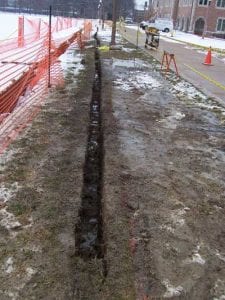 Air vs. Hydro Excavation – What’s the Difference?
Air vs. Hydro Excavation – What’s the Difference?
During National Safe Digging Month, we are highlighting topics that surround the hydrovac market and this equipment. As municipalities and contractors really take hold of this market in the United States, it’s important that operators understand the options and what will work best for their applications.
We’ve broken down the difference between air excavation and hydro excavation as well as some of the advantages and disadvantages of both.
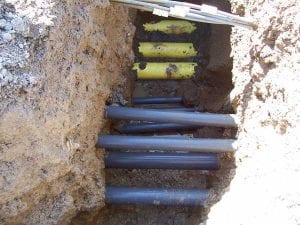
Air excavation is precisely as it sounds – a method of excavating soil and debris by using compressed air to break up soil and then vacuum into a unit’s debris tank. This is a great option for excavating when the application of water is not as readily available. In addition, air excavation vacuums the soil and debris as is – dry – into the debris tank. Once the project is complete, this material can be backfilled onto the project site. This allows for the unit to be clean of debris once the project is finished, and minimizes the need to locate a disposal site. One of the main disadvantages of air excavation is that it is slower than hydro excavation in most cases. Working air excavation can take more time to disrupt and break up debris to be cleared. In addition, it won’t work for all soil types. Loose, softer soil is a great option for air excavation, but tougher surfaces will need an abrasive such as water to help break that up.
Hydro-excavation is a method of excavating that utilizes high-pressure water and powerful vacuum to break up soil and remove. In order to complete hydro-excavation, a unit must feature a water capacity – ideally, one that is enough to complete several hours of hydro-excavating before it runs empty. Generally, hydro-excavation is a faster application than air excavation. The high-pressure water is able to more quickly break up soil and debris to be vacuumed out than air excavation. Hydro-excavation will work for all soil types, mentioned above. You don’t have to worry about getting to a jobsite with material that your unit cannot break up. However, the ability to return the soil back to the jobsite once a project is finished is not likely with hydro-excavation, as the debris is too saturated. This can be a disadvantage of hydro-excavation, as operators will need to complete proper disposal of the debris after the job. In addition, if you plan to be on the jobsite longer than your water capacity can hold, you will need to leave the site to refill your unit.
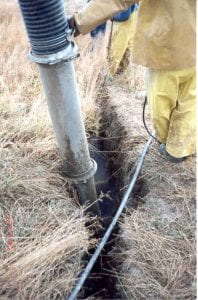 Due to the advantages and disadvantages of air and hydro excavation, it’s best to select a unit that can do both. Selecting an air/hydro combination unit gives you the best of both worlds. You will have the tools needed to tackle any soil type and virtually all applications.
Due to the advantages and disadvantages of air and hydro excavation, it’s best to select a unit that can do both. Selecting an air/hydro combination unit gives you the best of both worlds. You will have the tools needed to tackle any soil type and virtually all applications.
Vac-Con offers a range of products to meet the needs of public utilities, telecommunication companies, construction contractors, and more. Check out our latest product – the All-New X-Cavator – to see if it could be a fit for your next hydrovac job. We also offer trailer-mounted options that bring you the power in a portable unit. Learn more here.
Hydrovac Maintenance
Proper maintenance of your hydrovac unit is critical for the performance and durability of the machine. In order to get the most out of your unit, you must complete routine maintenance and replacement of some components.
Periodic maintenance is the lifeline of any machine. Abrasive material moves through the boom system at a high rate of speed. Failing to maintain boom system components will down your machine quickly. Filtration is another area of high-use on your hydrovac that you will want to pay attention to. Failure to maintain your filtration system will reduce performance and cause more expensive failures later own such as blowers, filters, etc.
To properly maintain your machine, refer to the manufacturer’s maintenance guidelines. Follow these instructions closely. Generally, schedules will be broken down to daily, weekly and monthly checkpoints. Following the general maintenance procedures will ensure that your machine is equipped to last and will provide you with the performance you require to efficiently do your job.
Vac-Con ONETOUCHSERVICE team is here to address your questions and concerns about your unit. We also offer refurbishment packages at our manufacturing facility to upgrade your unit to like-new. Contact us today! servicegroup@vac-con.com or call us at 904.529.1300. Check-out our refurbishment packages here.
Categorised in: Hydro Excavation
This post was written by Vac-Con

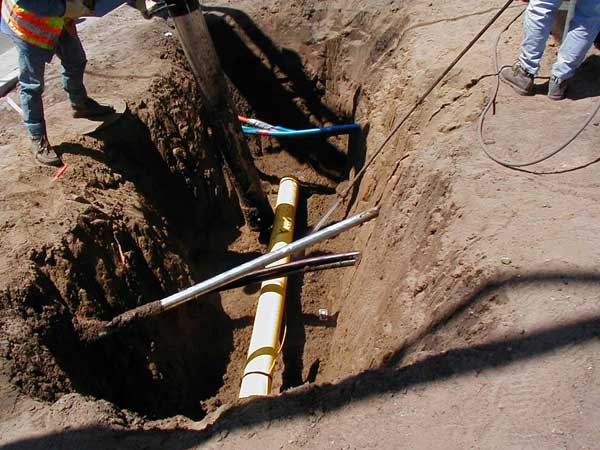
Comments are closed here.